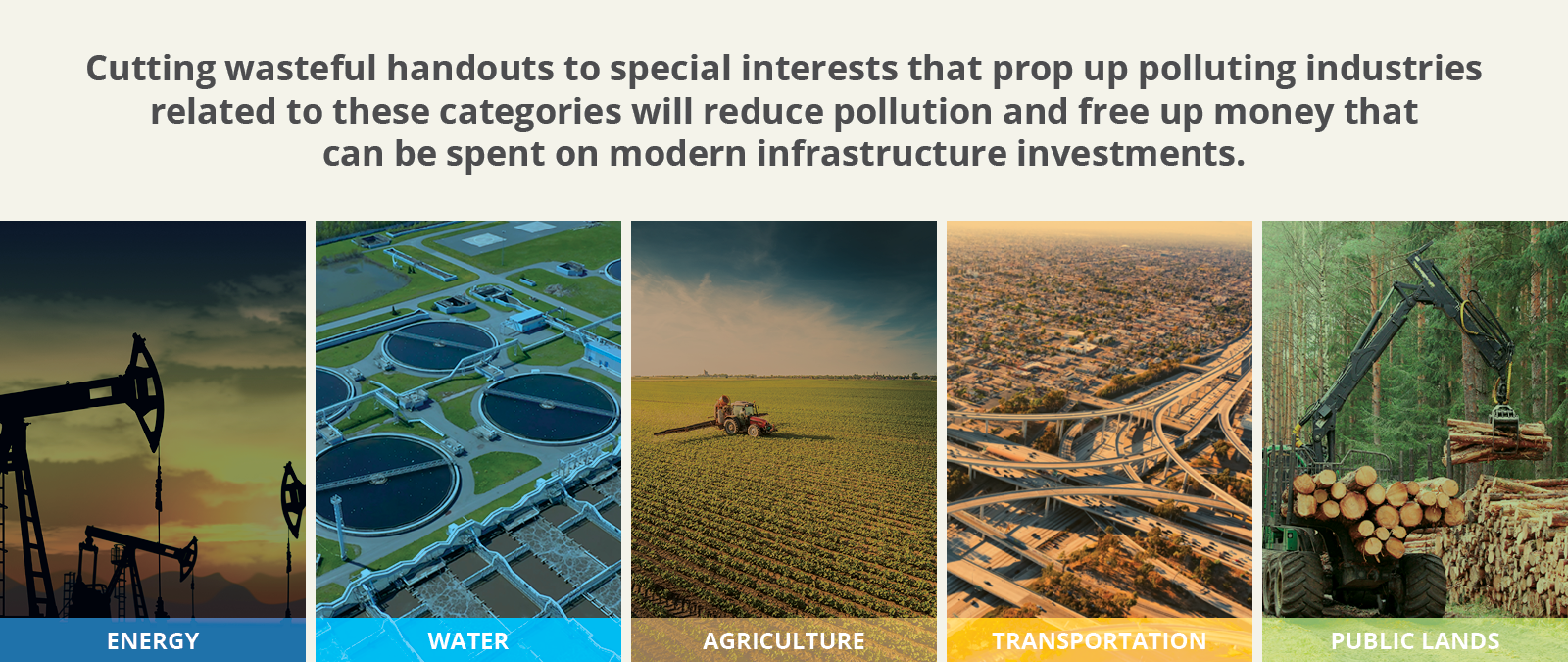Call on Congress to end fossil fuel subsidies
Every year, the federal government spends billions of taxpayer dollars on wasteful and environmentally harmful programs that are polluting our air and water and driving the climate crisis. Green Scissors is the definitive guide to polluter welfare in the federal budget.
A report by U.S. PIRG, Environment America, Taxpayers for Common Sense, R Street Institute and Friends of the Earth
VIEW THE FULL DATABASE
Every year, the federal government spends billions of taxpayer dollars on wasteful and environmentally harmful programs that are polluting our air and water and driving the climate crisis. Green Scissors is the definitive guide to polluter welfare in the federal budget.

The federal government is poised to make record investments in American infrastructure and the national debt continues to soar. At the same time, the impacts of climate change are all around us. Heat waves are ravaging the country, hurricanes are battering the Southeast and wildfires rage out of control across the West.
Green Scissors presents a solution to both our environmental and wasteful spending problems from an unlikely coalition of environmental, public interest, free market and taxpayer organizations. U.S. PIRG, Environment America, R Street Institute, Taxpayers for Common Sense and Friends of the Earth have chosen 2021 to revive Green Scissors, a project that began in the early 1990s, because of the urgency of the problems we’re facing now.
The idea behind Green Scissors is simple. The federal government should stop spending billions of taxpayer dollars on wasteful and environmentally harmful programs. This spending adds to the deficit and fails to protect the public interest. The majority of the Green Scissor list represents handouts to special interests that prop up polluting industries. Cutting this spending will reduce pollution and free up money that can be spent on modern infrastructure investments, such as clean energy and transportation.
For example, fossil fuel companies that drill on public lands or waters normally have to pay royalties for the oil and gas they extract. But the U.S. Department of the Interior can provide what is called “royalty relief,” where companies are granted exemptions
Green Scissors proposes more than 50 cuts that add up to nearly $296 billion in savings over ten years. They cover wasteful programs related to the categories of energy, water, agriculture, transportation and public lands. See how it’s broken down by category:
CASE STUDY: The Department of the Interior often provides what is known as “royalty relief,” granting exemptions from payments, while allowing companies to drill on public lands scot free. If this practice continues, it’s projected to cost taxpayers more than $3 billion over the next 10 years.
Photo credit: Robert Lucian Crusitu via ShutterstockCASE STUDY: The 11-member Inland Waterways Users Board consists of industry representatives and represents commercial interests, not environmental or public interests. Taxpayers fully finance the activities of the board, including staff and support services.
Photo credit: chekart via ShutterstockCASE STUDY: The federal crop insurance program forces taxpayers to subsidize $8 billion in insurance premiums for large agribusinesses every year.
Photo credit: Fotokostic via ShutterstockCASE STUDY: The Essential Air Service program created in the 1970s subsidizes commercial flights to rural airports. But many of the cities subsidized are now within close driving distance to airports without subsidized flights. The program will cost taxpayers $3 billion over the next ten years.
Photo credit: TierneyMJ via ShutterstockAs a result of the 1872 mining law, companies pay no royalties for the minerals they remove from federal lands and allows them to purchase federal land for between $2.50 and $5.00 per acre, undercutting the true value and allowing them to extract minerals on the taxpayers dime. Reforming this law would save over $3 billion over the next ten years.
Photo credit: Kletr via Shutterstock1of 5
Nearly thirty years ago, an unlikely alliance was formed when our groups launched the first Green Scissors project. Today, this work is as important as ever. We won’t be able to tackle climate change and preserve clean water and air for future Americans if we keep subsidizing polluters with taxpayer dollars.
Sign Up
